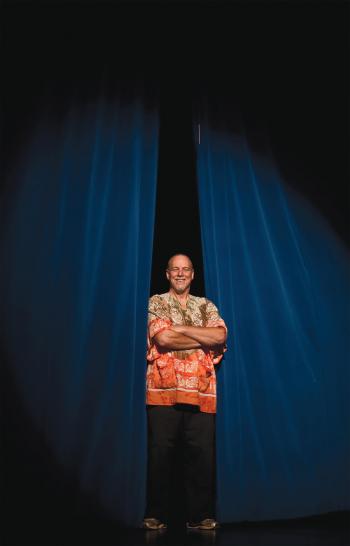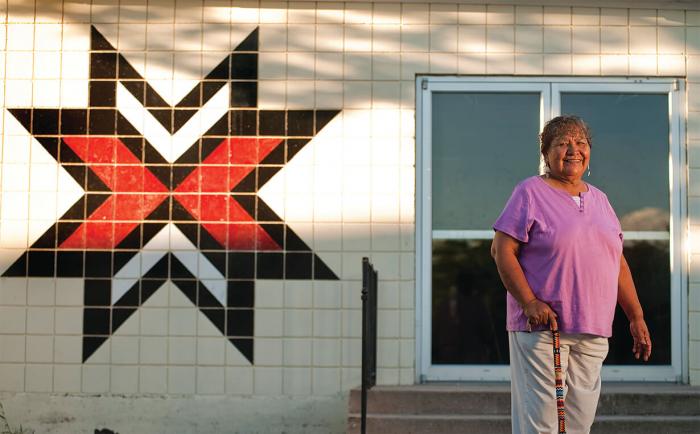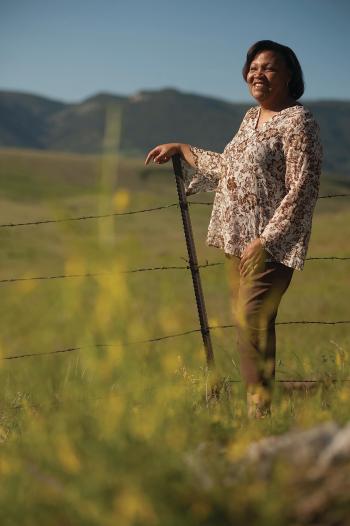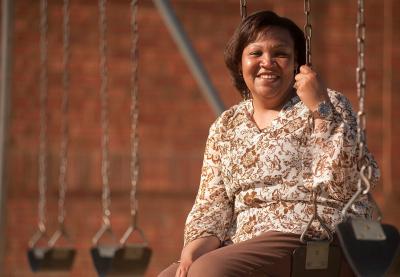Georgia: Who’s a Rebel?

David Dixon knew he was far from home when he pulled up to his new school and saw a Confederate battle flag, about 15 feet long, painted on the side of the gym.
“I knew Haralson County’s mascot was the rebel, but I’m not sure I expected this,” he said, chuckling. “It’s just a different world down here.”
Dixon teaches theater at Haralson County High School in the Appalachian foothills of northern Georgia. Atlanta is only about an hour away, if you take the interstate, but these sparsely populated hills seem far removed from the Southern metropolis. With a total population of around 25,000, Haralson County is the kind of place where only churches are open on Sunday morning, and where it’s hard to fill pews during deer season.
David Dixon came here as a sort of economic refugee. After a long career in various school-related positions in Michigan—and many years performing in community theater—Dixon made a mid-life decision to become a full-time theater teacher. His new career was just getting started when the bottom fell out of Michigan’s already-shaky economy.
“I had a friend who was a special education teacher, and he got laid off,” Dixon said. “When they’re letting go of special ed people, you know it’s bad. So we decided to go.”
At a job fair, he came across an opening in Haralson County, where local theater advocates had managed to get a new theater built. The school system was looking for a drama teacher to help them put that theater to use. Dixon jumped at this rare chance—a chance to start a drama program in a Title I school.
As a Rust Belt native, Dixon recognizes much of the dynamic he sees in his classroom. An outsider might not notice a lot of social stratification in this 90 percent white county, but Dixon says there’s a strong undercurrent of class warfare between his rural students and more affluent “city” kids in nearby Bremen, a town of 4,600 people.
Other things, though, make Dixon shake his head in wonder. He’s sure there are gay people in this community, but the topic is never discussed openly here. Race is another third rail. And these genteel Southerners turn fierce when you lay a hand on their local traditions.
“Not long ago, there was a proposal to build a new gym, without the rebel flag,” he said. “During that football season, it was almost like a revolution here.”
The local discourse has had an effect on Dixon’s budding theater program. Interest in the program has been high overall—but African-American students seem reluctant to sign up, no matter how aggressively Dixon recruits them.
“I can’t get anybody to really tell me why,” he said. “But I have noticed that many of the students who take my class are also in the band, and there aren’t a lot of black kids in the band.”
The band can be a touchy subject for Dixon. For years, the Haralson County band had an odd initiation ritual: Rookie band members were “auctioned off” to upperclassmen during band camp. They had to spend the summer acting as servants to the band members who bought them. Dixon spoke out against the practice. Band boosters didn’t take it well.
“I’m reluctant to even talk about that one,” he said. “It’s clear that the band alumni see this as an honored tradition, one you don’t touch.”
Dixon said he has also been surprised by the number of students who have family members in jail or prison, largely due to the epidemic of methamphetamine use. And he is surprised at the number of students who have been assaulted. Some of those students, he said, seem drawn to drama classes, as a way to work out their feelings.
Still, it wouldn’t be fair to characterize Dixon’s students as victims. He describes them as eager, genuine, surprisingly open to new experiences. Many of them, he said, feel a strong sense of place, and would like to stay in Haralson County after graduation. Still, they know the options here are limited, and many are sure the post-graduation job search will take them to Atlanta or some other city.
Theater, Dixon says, can help with that.
“There are important, basic job skills that are hard to get here,” Dixon said. “If you’re white and you’ve never spent significant amounts of time with Hispanic and black people, you’re going to be uncomfortable when you enter the modern workplace.
“We need to give them a way to experience real diversity, and the diversity we have here is something we don’t talk much about,” he said. “Theater can fill that space. It pushes you to see things from someone else’s perspective.”
And theater is something Haralson County is genuinely open to. Dixon says he “cut the crap out of” Grease to avoid offending local mores. When the school put on a one-act play with an oblique reference to a lesbian couple, a local pastor told Dixon that the mention of gay people in a school play should be illegal.
But for the most part, people come to the plays, clap, and feel proud.
"We need to give them a way to experience real diversity, and the diversity we have here is something we don't talk much about. Theater can fill that space. It pushes you to see things from someone else's perspective."
David Dixon
This year, they’re putting on Joseph and the Amazing Technicolor Dreamcoat. Maybe some one will object, accusing the school of playing fast and loose with scripture. But so far, the community seems to be warming to a play that covers a story they know and respect.
“I have 15 young men in this play, and all of them are pretty good dancers,” he said. “What are the chances that you’d find that in a big-city school, much less Haralson County, Georgia? It’s amazing.”

South Dakota: Strong Enough to Be Lakota
Philomine Lakota is 63 years old. And before she retires, she has to teach her students everything.
Everything. The word for ocean. The word for sky. How to express love, how to tell a story. Why it’s important to know your father’s name.
“I was never formally educated in the Lakota Language,” she said. “My generation is probably the last to learn it the old way—in early childhood, from parents and grandparents.”
Lakota is one of two teachers of Lakota language and studies at the Red Cloud Indian School on the Pine Ridge Reservation in South Dakota. To an outsider, Red Cloud might seem like just another rural high school—a small building full of hopeful people, surrounded by the bleak majesty of nature.
But long-time residents like Philomine Lakota know that the school is the product of a long conflict between monolithic forces. Pine Ridge is where many of the Lakota people were settled after the Great Sioux War of 1877, the last great Native American offensive against U.S. expansionism.
Today Pine Ridge is the poorest reservation in America and one of the poorest locales in the United States. The unemployment rate here is rarely below 70 percent. Drug and alcohol abuse are rampant. Statisticians say an average person born here can expect to live to about 50, a quarter-century lower than the nationwide average. That number is due in part to a staggering number of teen suicides and the highest infant mortality rate in the United States.
Red Cloud Indian School is one truly bright spot amidst the misery. Once known as Holy Rosary Mission, the school is now named for Red Cloud, the great Oglala war leader who invited the Jesuits to build a school here. Locals will tell you that the school offers Pine Ridge kids their best shot at college. The school competes in, and wins, national contests in science. And the school is struggling mightily to turn the knowledge in Philomine Lakota’s head—an entire language, along with the stories and worldview that come with it—into a curriculum for the high school classroom.
“I know it’s not impossible to teach the Lakota language,” she said. “Clearly, that has been done again and again. But it’s a great challenge to teach it in the classroom because I didn’t learn it formally.”
Every day, Philomine Lakota faces a classroom of 10th graders eager to learn. Most know only a smattering of words like unchi, or grandmother. They don’t know how to fit the words together, or how to make sentences of their own.
“I conduct as much of the class as I can in Lakota,” she said. “The students always say, wait, we can’t understand you. And I say don’t worry, you’ll pick it up. It’s your language.”
Many of her students live in the remote Badlands, and their parents drive them more than half an hour just to reach the bus route. Hunger is a serious problem, and Lakota often brings snacks to her classroom knowing they are more than a treat.
With so much hardship on the reservation, a language course might seem to be a luxury. Philomine Lakota sees the language as the foundation for other skills.
“One of our biggest challenges here is the cultural identity problem,” she says. When students leave the reservation—or even when they watch television—they’re exposed to racist stereotypes that tell them who they are. Students often aren’t able to push back effectively against those stereotypes, she says, because they simply don’t know enough of the Lakota story.
“At Red Cloud, there’s a strong focus on going away to college,” said Lakota. “But it’s scary out there. There is a lot of racism. There is culture shock. A lot of people who go out of the reservation become involved in drug use because of this.”
Lakota finds that her students are more than eager to learn about their culture. They may not crowd around her and ask to hear old stories. But they have plenty of questions about Lakota life in the past. “Maybe it’s just because I am their image of a grandmother,” she said. “But they show a great deal of respect. They’re eager to know.”
But Philomine Lakota knows her students need more than curiosity and knowledge. They need to be strong in their Lakota identity, she said.
For teens in an English-dominant culture, this can be harder than it sounds. The school is helping out, in part by instituting a rule that all classroom requests—for a hall pass or a bathroom break, for instance—have to be in Lakota. Philomine Lakota recently acted as announcer for a home basketball game and did the announcing in Lakota. And the school’s cheerleaders practiced Lakota cheers, as well as the “trill.” It is a ululating cry Lakota women have traditionally given to show they are proud of their men.
But when the other team showed up from a predominantly white school, the cheerleaders were too bashful to do the trill.
“They’re weren’t strong enough. Not yet,” she said.
Not yet. But there are encouraging signs. Philomine Lakota does the trill herself at basketball games and wrestling matches. She says the athletes now come up to her and ask if she is going to “do ‘le-le-le’ for them.” At a recent match, the teacher did give the trill. And she was answered by another “le-le-le” from a small group of 11 and 12-year-olds.
“That meant a lot to me,” she said. “It’s a sign that we’re moving in the right direction.”
Wyoming: Ambassador to Rawlins

Depending on how you look at it, Valerie Lane is either in teaching heaven or a kind of comical hell.
When her first-graders ask probing questions about the color of her skin or the texture of her hair, Lane feels that Rawlins, Wyoming, is where she is meant to be.
But she feels a little differently when she’s driving to Casper—115 miles away—to get a haircut.
“I actually had a cosmetologist [in Rawlins] tell me, very innocently, that she doesn’t know how to do ‘colored hair,’” Lane says, chuckling. “I’m talking about a 22-year-old woman saying this.
“That’s Rawlins,” Lane continues. “People are very open and fair minded, but there’s a lot they don’t know, because they never had the chance to learn.”
Lane grew up in Casper, the 55,000-person city that is one of Wyoming’s biggest population centers. But today she is one of a handful of black teachers in Carbon County, a thinly populated expanse of scenic mountains and forests along the Continental Divide. Carbon County is twice the size of California’s sprawling Los Angeles County. But here, the total population is just over 15,000.
If you live in Rawlins, chances are you work in the oil fields, or at the nearby state penitentiary. If not, you probably work in a business that serves the needs of people who do.
Historically, this area has been overwhelmingly white, though Carbon County is seeing some small changes. The collapse of the Rust Belt job market has attracted many Midwesterners to Wyoming, bringing a new level of racial and ethnic diversity.
Somehow, when children of color arrive in Rawlins, they always seem to find their way into Valerie Lane’s class. And she’s fine with that. Lane sees herself very much as an ambassador here, sharing new worlds with white students and giving African-American, Latino and Asian students a chance to see themselves reflected in the curriculum.
“I love the questions my students ask,” she said. “They’re very open, and they really want to know things. They want to know about my hair, and they want to know why one of my students—who is from Detroit—has an accent. We find ways to talk about these things and learn.”
Many of her students have never seen a black teacher before, and many parents haven’t either. For a teacher with a background in multicultural education, the wonder of this small mountain town means that every moment is a teachable moment.
The downside, of course, is that even the best teacher can’t be in “teacher mode” all the time. And Lane finds herself constantly, patiently, teaching the same lesson over and over again—even with adults, even when school is out.
“Some people in Rawlins have never seen an African American, except on MTV and reruns of Cops,” she said, again chuckling. “So you can imagine the perceptions they have.”
Those perceptions have occasionally made her work difficult, Lane admits, though she is reluctant to talk specifics. “Let’s just say that I have had to prove myself in a way others have not,” she said.
Lane isn’t alone in that experience. When University of Wyoming researchers set out to document the experiences of teachers of color in Wyoming towns of fewer than 2,500 people, the results were both inspiring and disturbing.
The researchers found that teachers were highly motivated by a desire to change their students’ lives. They also reported that students, parents and colleagues often questioned their credentials. They said their students often saw them as “freakish” because they didn’t conform to pop-culture stereotypes of African Americans and Latinos. They reported feeling invisible and isolated.
At least the curriculum is on her side, Lane said. She praised the school district for a reading curriculum that includes diverse topics and characters—including American Indian stories and articles on Rosa Parks and Jackie Robinson.
To some, that may sound like a “heroes and holidays” approach. But Lane says it’s far better than the curriculum she recalls from her own Wyoming childhood.
“When I was in school in Casper, the only black people we saw in the media were committing crimes and going to prison,” she said. “At 45, seeing African-American stories in a textbook still gives me a sense of pride.”
Lane thinks often about Casper, where students have school-issued laptops and the school system addresses de facto segregation by promising to transport any student, in any community, to the school of their choice. As a sparsely populated, oil-rich state, Wyoming enjoys the funding that can make those programs happen.
But Lane wishes more of that money could find its way to Carbon County, where teacher pay is lowest in the state. And she worries about the number of dropouts in local high schools. She believes the dropout rate is due in large part to students’ belief—real or imagined—that oilfield jobs will be waiting for them, with or without a diploma.
“I don’t want to say that Rawlins isn’t the real world,” she said. “But when I look around—at our one supermarket, our one furniture store—I know that this is just not the way things are in the rest of the world.”
That’s why Lane talks to her students about how to get into college, even though graduation is more than a decade away.
“If they want to come back to Rawlins after college, that’s fine,” she said. “But they need the tools to do more.”
